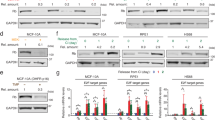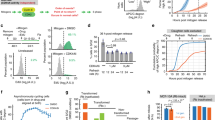Abstract
Deregulation of the retinoblastoma protein (pRB) pathway is a hallmark of cancer1. In the absence of other genetic alterations, this deregulation results in lack of differentiation, hyperproliferation and apoptosis2. The pRB protein acts as a transcriptional repressor by targeting the E2F transcription factors, whose functions are required for entry into S phase3,4. Increased E2F activity can induce S phase in quiescent cells—this is a central element of most models for the development of cancer1,3,4. We show that although E2F1 alone is not sufficient to induce S phase in diploid mouse and human fibroblasts, increased E2F1 activity can result in S-phase entry in diploid fibroblasts in which the p53-mediated G1 checkpoint is suppressed. In addition, we show that E2F1 can induce S phase in primary mouse fibroblasts lacking pRB. These results indicate that, in addition to acting as an E2F-dependent transcriptional repressor, pRB is also required for the cells to retain the G1 checkpoint in response to unprogrammed proliferative signals.
This is a preview of subscription content, access via your institution
Access options
Subscribe to this journal
Receive 12 print issues and online access
$209.00 per year
only $17.42 per issue
Buy this article
- Purchase on Springer Link
- Instant access to full article PDF
Prices may be subject to local taxes which are calculated during checkout





Similar content being viewed by others
References
Hanahan, D. & Weinberg, R.A. The hallmarks of cancer. Cell 100, 57–70 (2000).
Lipinski, M.M. & Jacks, T. The retinoblastoma gene family in differentiation and development. Oncogene 18, 7873–7882 (1999).
Dyson, N. The regulation of E2F by pRB-family proteins. Genes Dev. 12, 2245–2262 (1998).
Harbour, J.W. & Dean, D.C. The Rb/E2F pathway: expanding roles and emerging paradigms. Genes Dev. 14, 2393–2409 (2000).
Johnson, D.G., Schwarz, J.K., Cress, W.D. & Nevins, J.R. Expression of transcription factor E2F1 induces quiescent cells to enter S phase. Nature 365, 349–352 (1993).
Qin, X.-Q., Livingston, D.M., Kaelin, W.G. & Adams, P. Deregulated E2F1 expression leads to S-phase entry and p53-mediated apoptosis. Proc. Natl Acad. Sci. USA 91, 10918–10922 (1994).
Shan, B. & Lee, W.-H. Deregulated expression of E2F-1 induces S-phase entry and leads to apoptosis. Mol. Cell. Biol. 14, 8166–8173 (1994).
Dimri, G.P., Hara, E. & Campisi, J. Regulation of two E2F-related genes in presenescent and senescent human fibroblasts. J. Biol. Chem. 296, 16180–16186 (1994).
Lukas, J., Petersen, B.O., Holm, K., Bartek, J. & Helin, K. Deregulated expression of E2F family members induces S-phase entry and overcomes p16INK4A-mediated growth suppression. Mol. Cell. Biol. 16, 1047–1057 (1996).
Quinlan, M.P., Sullivan, N. & Grodzicker, T. Growth factor(s) produced during infection with an adenovirus variant stimulates proliferation of nonestablished epithelial cells. Proc. Natl Acad. Sci. USA 84, 3283–3287 (1987).
Zerler, B., Roberts, R.J., Mathews, M.B. & Moran, E. Different functional domains of the adenovirus E1A gene are involved in regulation of host cell cycle products. Mol. Cell. Biol. 7, 821–829 (1987).
Vigo, E. et al. CDC25A phosphatase is a target of E2F and is required for efficient E2F-1 induced S phase. Mol. Cell. Biol. 19, 6379–6395 (1999).
Moroni, M.C. et al. APAF-1 is a transcriptional target for E2F and p53. Nature Cell Biol. 3, 552–558 (2001).
Müller, H. et al. E2Fs regulate the expression of genes involved in differentiation, development, proliferation and apoptosis. Genes Dev. 15, 267–285 (2001).
Sherr, C.J. Tumor surveillance via the ARF-p53 pathway. Genes Dev. 12, 2984–2991 (1998).
Jacobs, J.J.L., Kieboom, K., Marino, S., DePinho, R.A. & van Lohuizen, M. The oncogene and Polycomb-group gene bmi-1 regulates cell proliferation and senescence through the ink4a locus. Nature 397, 164–168 (1999).
Vogelstein, B., Lane, D. & Levine, A.J. Surfing the p53 network. Nature 408, 307–310 (2000).
Mann, D.J. & Jones, N.C. E2F-1 but not E2F-4 can overcome a p16-induced G1 cell-cycle arrest. Curr. Biol. 6, 474–483 (1996).
Macleod, K.F., Hu, Y. & Jacks, T. Loss of Rb activates both p53-dependent and independent cell death pathways in the developing mouse nervous system. EMBO J. 15, 6178–6188 (1996).
Harrington, E.A., Bruce, J.L., Harlow, E. & Dyson, N. pRB plays an essential role in cell cycle arrest induced by DNA damage. Proc. Natl Acad. Sci. USA 95, 11945–11950 (1998).
Brugaloras, J. et al. Inhibition of cyclin-dependent kinase 2 by p21 is necessary for retinoblastoma protein-mediated G1 arrest after γ-irradiation. Proc. Natl Acad. Sci. USA 96, 1002–1007 (1999).
Lasorella, A., Noseda, M., Beyna, M., Yokota, Y. & Iavarone, A. Id2 is a retinoblastoma protein target and mediates signalling by Myc oncoproteins. Nature 407, 592–598 (2000).
Helin, K., Harlow, E. & Fattaey, A.R. Inhibition of E2F-1 transactivation by direct binding of the retinoblastoma protein. Mol. Cell. Biol. 13, 6501–6508 (1993).
Helin, K. & Harlow, E. Heterodimerization of the transcription factors E2F-1 and DP-1 is required for binding to the adenovirus E4 (ORF6/7) protein. J. Virol. 68, 5027–5035 (1994).
Fattaey, A.R., Harlow, E. & Helin, K. Independent regions of adenovirus E1A are required for binding to and dissociation of E2F-protein complexes. Mol. Cell. Biol. 13, 7267–7277 (1993).
Kamijo, T. et al. Tumor suppression at the mouse INK4a locus mediated by the alternative reading frame product p19ARF. Cell 91, 649–659 (1997).
Jacks, T. et al. Effects of an Rb mutation in the mouse. Nature 359, 295–300 (1992).
Jacks, T. et al. Tumor spectrum analysis in p53-mutant mice. Curr. Biol. 4, 1–7 (1994).
Brugarolas, J. et al. Radiation-induced cell cycle arrest compromised by p21 deficiency. Nature 377, 552–557 (1995).
Helin, K. et al. Heterodimerization of the transcription factors E2F-1 and DP-1 leads to cooperative transactivation. Genes Dev. 7, 1850–1861 (1993).
Acknowledgements
We thank A. Fattaey, P.G. Pelicci, G. Peters, N. Dyson and members of the Helin laboratory for discussions, and C. Attwooll, A. Fattaey and N.H. Heintz for comments on the manuscript. M.R.J. was supported by a Marie Curie fellowship from the European Union. This work was supported by grants from the Associazione Italiana per la Ricerca sul Cancro, the Fondazione Italiana per la Ricerca sul Cancro, The Italian Health Ministry and the Human Frontiers Science Program.
Author information
Authors and Affiliations
Corresponding author
Ethics declarations
Competing interests
The authors declare no competing financial interests.
Supplementary information
Rights and permissions
About this article
Cite this article
Lomazzi, M., Moroni, M., Jensen, M. et al. Suppression of the p53- or pRB-mediated G1 checkpoint is required for E2F-induced S-phase entry. Nat Genet 31, 190–194 (2002). https://doi.org/10.1038/ng891
Received:
Accepted:
Published:
Issue Date:
DOI: https://doi.org/10.1038/ng891
This article is cited by
-
The metabolic stress-activated checkpoint LKB1-MARK3 axis acts as a tumor suppressor in high-grade serous ovarian carcinoma
Communications Biology (2022)
-
Novel interactions of the von Hippel-Lindau (pVHL) tumor suppressor with the CDKN1 family of cell cycle inhibitors
Scientific Reports (2017)
-
Isoform-specific interactions of the von Hippel-Lindau tumor suppressor protein
Scientific Reports (2015)
-
Dystonia, facial dysmorphism, intellectual disability and breast cancer associated with a chromosome 13q34 duplication and overexpression of TFDP1: case report
BMC Medical Genetics (2013)
-
INMAP, a novel truncated version of POLR3B, represses AP-1 and p53 transcriptional activity
Molecular and Cellular Biochemistry (2013)



